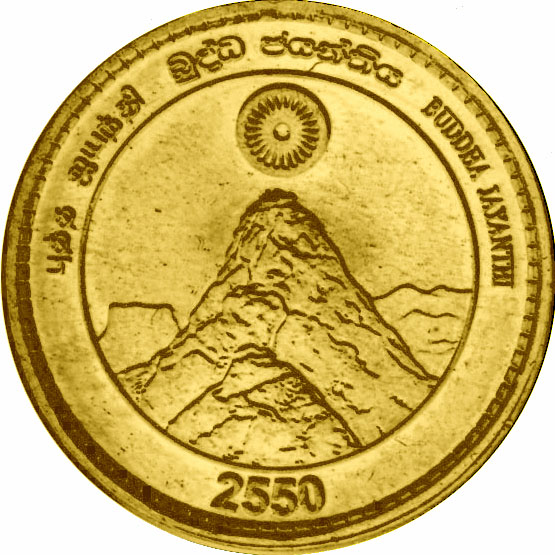
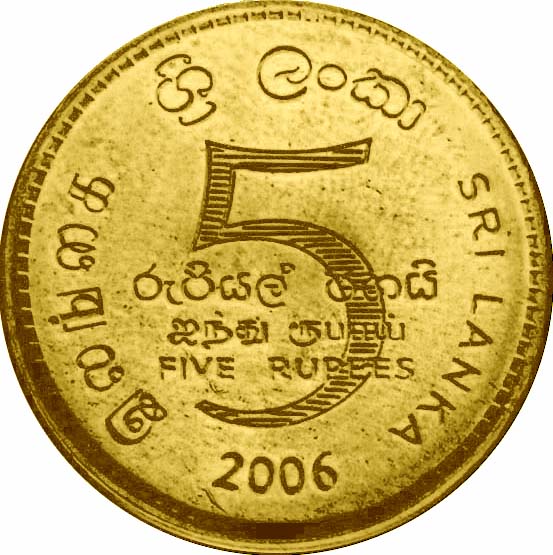
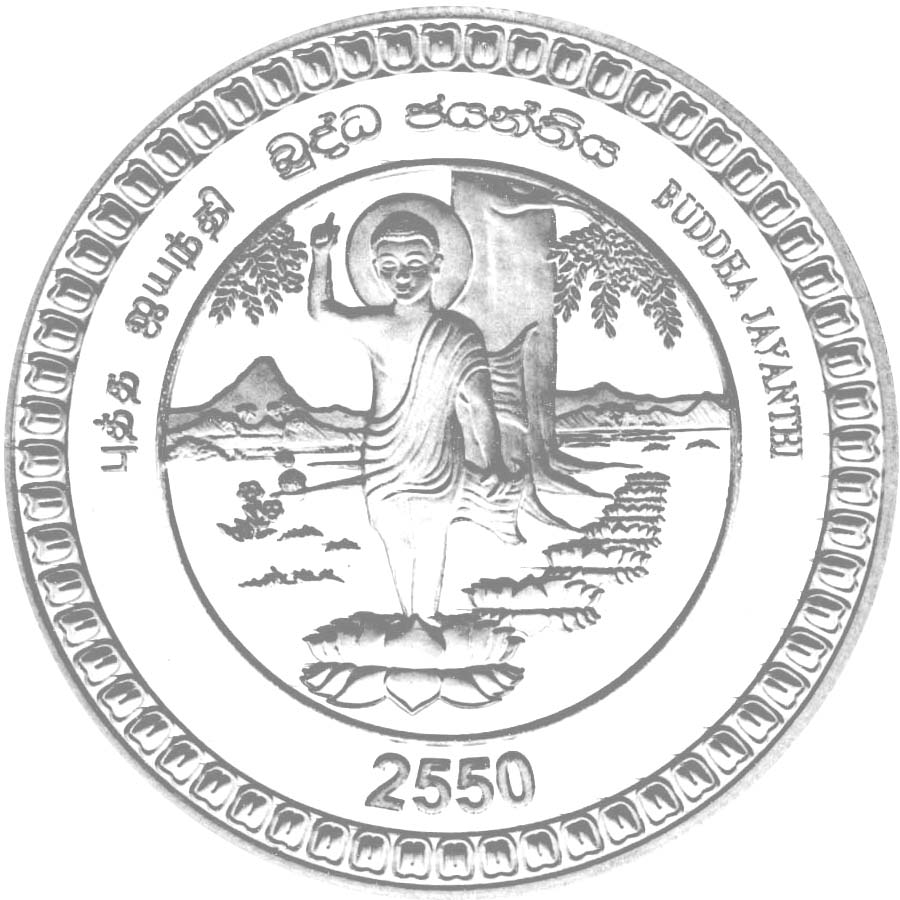
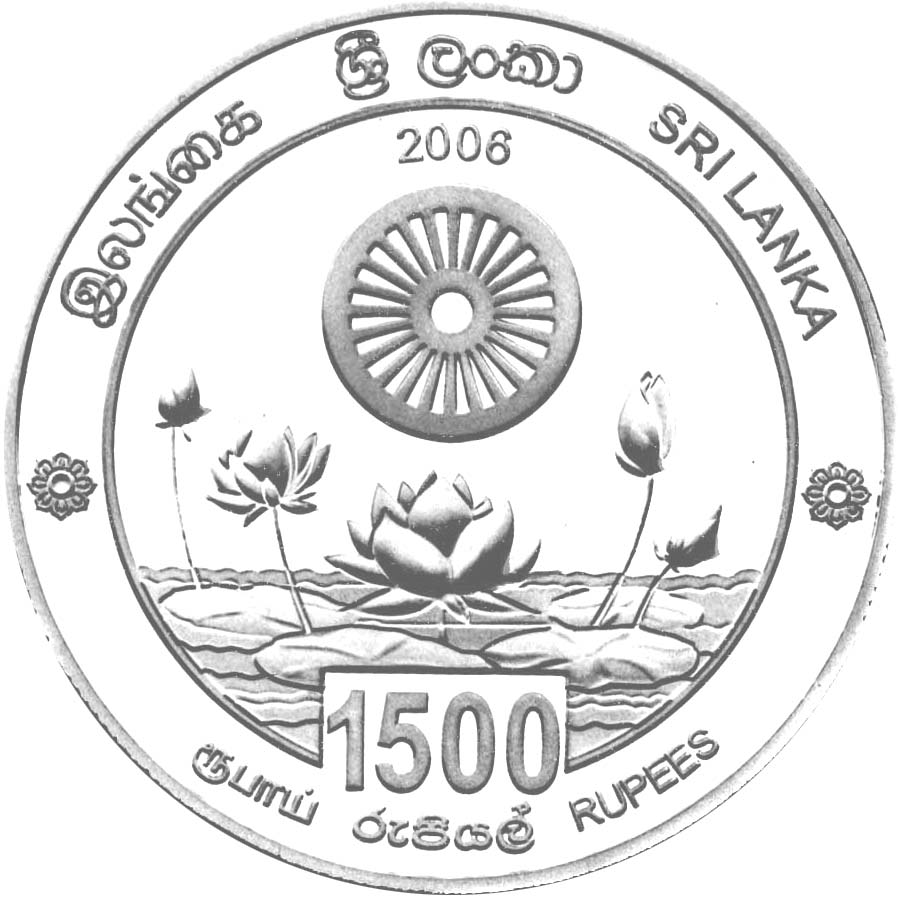
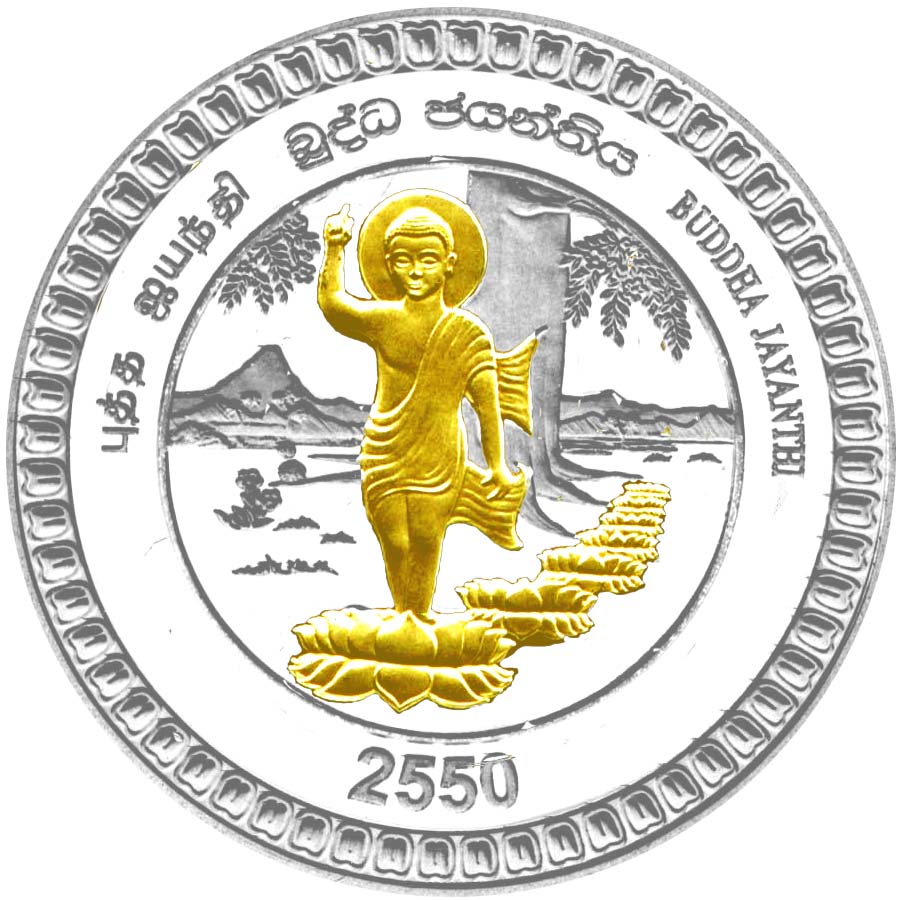
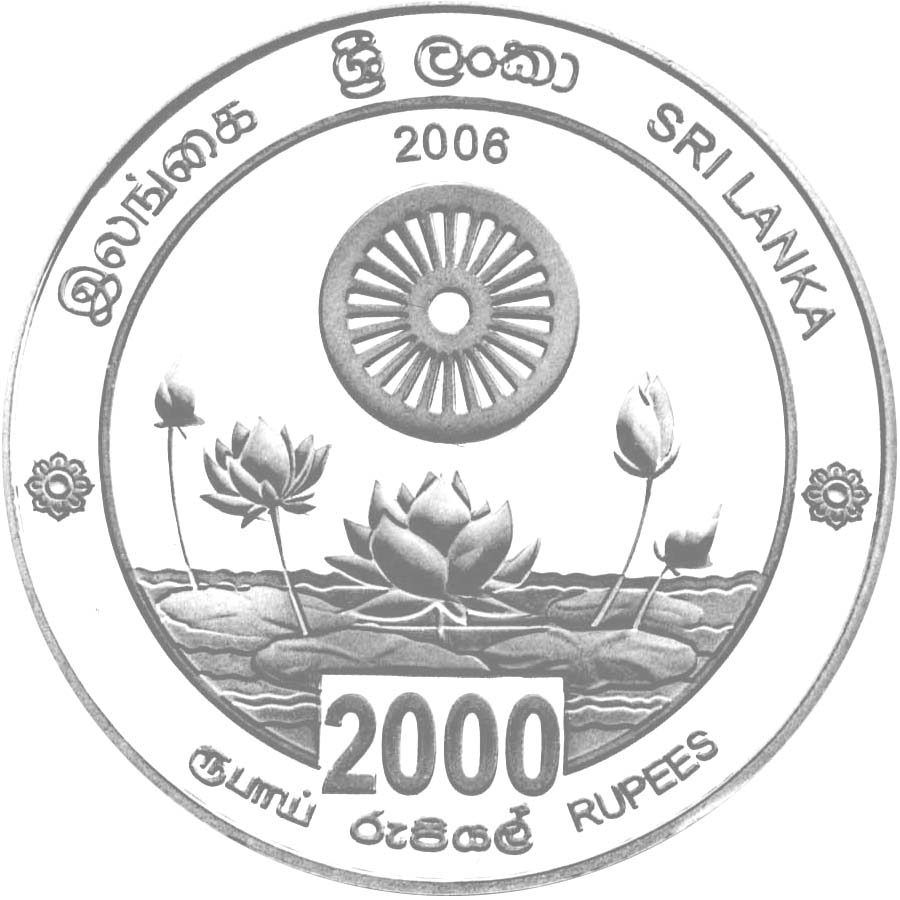
The two crown size sterling silver Rs2000/- and Rs1500/-, commemorative frosted Proof coins depict the same scene from the Birth of the Buddha. A brass plated steel Rs5/- coin will also be issued into circulation with image of SiriPada Mountain below a Dharma Chakra.

| 
|

| 
|

| 
|
In the Rs 2000/- coin the seven lotuses and the Bodhisatva Siddhartha is plated in gold. On the reverse, above a lake with lotus, is shown a 24 prong Dharma Chakra as found on the Ashoka pillar at Saranath in Varanasi, where Buddha taught his Dharma to his first disciples.
According to the traditional belief, Siddhartha after his birth in Lumbini took seven steps under which seven lotus blossoms appeared, while announcing his forthcoming Enlightenment.
In the Buddha Dharma worldly nature is resembled to a lake of lotus blossoms. Just as there exist in a lake young buds, mature buds and buds about to bloom, in the world of human too there exists men of diverse levels of attainment of conciousness. Disciples like lotus in the lake, bloom by the radiance of the Dharma represented by the Chakra.
Buddhism as a religion with some mythological beliefs and worship adopted by a majority in Sri Lanka is represented on the obverse. Buddhism as a Philosophy, a pure Dharma practiced through meditation and being adopted by a growing International community, is represented in abstraction on the reverse. Like the Ying and the Yang on two sides of the same coin.
The coins were designed by Mr Kelum Gunasekara of Kelaniya who also designed 5 of the 50 Stamps issued by Philatelic Bureau for the 2550 Buddha Jayanthi.
The Royal Mint in Wales has minted for CBSL 10,000 of these gold embossed silver proof coins with a face value of Rs2000/- and are sold at Rs7000/- each. The 20,000 of silver Proof coins which have the same design except for the face value of Rs1500/- and are sold at Rs5000/-
It is unfortunate that the doubling of the price of silver in the last 8 months and the cost of production has required CBSL in collaboration with the Buddha Sasana Ministry to decide to sell the coins at a very high premium above the face value. That will make the coin unaffordable to most coin collectors in Lanka. It remains to be seen as to how many would buy this Rs2000/- coin at Rs7000/- or the Rs1500/- coin at Rs5000/-, more than three times the price of very similar silver proof commemorative coins sold currently at CBSL.
It also seemed a pity that the coins produced as a special rush order was only released for sale to the public after Vesak, on May 15th. However technically it should be the case, since May 11 before Vesak was in B.E. 2449.
Limited quantities are available at the Central Bank, The Currency Museum located at the Center for Banking Studies, in Rajagiriya. Ministry of Religious Affairs, and selected branches of Bank of Ceylon and Peoples Bank.
The Proof coins are issued in a presentation box enclosed within a plastic coin capsule. Please remember that these Proof coins which are Minted individually without touching by Human hand should not be taken out of the Plastic case in which they are issued. A finger print on a Proof coin will destroy the numismatic premium on the coin, which in this case has been made to be a lot more than the face value.
The coin will clearly sell now to a few dedicated collectors. However I suspect most will wait till the long term devaluation of the Rupee and the increase in price of silver makes today's high price more attractive in a few years. Such was the case for the 1998 Rs5000/- gold sovereign which was sold by CBSL for Rs8000/-.
Usually CBSL has sold the silver commemorative coins at cost of Minting them which is just above the face Value. For example In 1998, 1999 and 2000, CBSL issued three silver crown sized coins for 50th Anniversary of Independence, Cricket World Cup, and 50th Anniversary of CBSL. According to the 2005 CBSL Annual report, of the 60,000 Rs1000/- coins minted 36,400 have been sold to the public by the end of 2005. In year 2005 only about 900 have sold at Rs1200/- each, even though they now have about Rs1100/= of silver at current world market price. The price of these coins have now been increased to Rs1600/=
This is the third Buddhist commemorative silver coin issued by Sri Lanka in Modern Era and clearly as beautiful as the first two. The first a Rs5 coin was issued in April 1957 for the 2500 Buddha Jayanthi and still considered as one of the most beautiful crown size coins in the world. The next was the Rs500 issued in June 1993, for the 2300 Anubudu Mihindu Jayanthiya, and has been for example selected the front cover of the 2007 Standard Catalog of World coins to be published this month by Krause in USA.

The 1957 Buddha Jayanthi Rs5/- coin has been popular among even non-collectors and was issued into circulation at the face value. CBSL has plans to also sell 1957 Rs5/- coins from circulation to the public. Till 1991 CBSL was not authorized to sell any coin above the face value. Although 500,000 of the 1957 rs5/- coins were minted 258,000 were returned to the Royal Mint in 1962 November, to melt as silver bullion when the price of silver exceeded the face value. Many more have probably been melted to make jewelry. 50 years later uncirculated coins sells in the World Numismatic Market for about US$25. The far more rare Proof of this same issue with only 1800 minted sells for about $60.
 Twenty Million of the 2550 Buddha Jayanthi Rs5/- coins will be issued
into circulation. However only few have been sent so far from the Royal Mint
and it will probably be a few months before you see one in circulation.
The line drawing of Siri Pada sent by CBSL clearly
illustrates the steps up the side of the mountain and the buildings on top.
However the reduction of scale at Royal Mint seems to have returned
SiriPada back to nature.
Twenty Million of the 2550 Buddha Jayanthi Rs5/- coins will be issued
into circulation. However only few have been sent so far from the Royal Mint
and it will probably be a few months before you see one in circulation.
The line drawing of Siri Pada sent by CBSL clearly
illustrates the steps up the side of the mountain and the buildings on top.
However the reduction of scale at Royal Mint seems to have returned
SiriPada back to nature.
The year 1957 on the 2500 B.E. coin and the 2006 date on the 2550 B.E. coin is going to confuse many numismatists who are unaware that the Buddhist Era in Sri Lanka changes on Vesak (May) Full Moon Poyaday. However in reality the difference is even greater. The 2550 B.E. year is on the standard Buddhist Era calender which is started on 544 BCE. The Mahavamsa clearly states that the coronation of Emperor Asoka (265 BCE. was 218 B.E. or years after Buddha's Parinibbana at age 80. So with modern historical dating 2006 is 2489 years after the Parinibbana of the Buddha, and 2569 years after the birth depicted on the silver coins. So in reality it is now 2550 years from when the Prince Siddhartha became 19 years old.
Looking at recent News reports I notice that the year 2550 is associated with either the Birth in east Asia and Parinibbana in south Asia.
Author maintains an educational website on 2300 years of Lankan coins at http://coins.lakdiva.org.lk/, and is Vice President of the Sri Lanka Numismatic Society.
See also 2006 - Buddha Jayanthi 2550 B.E. Sri Lanka in LakdivaCoins